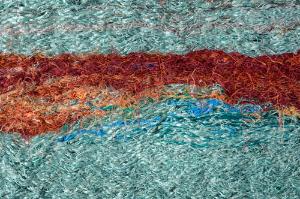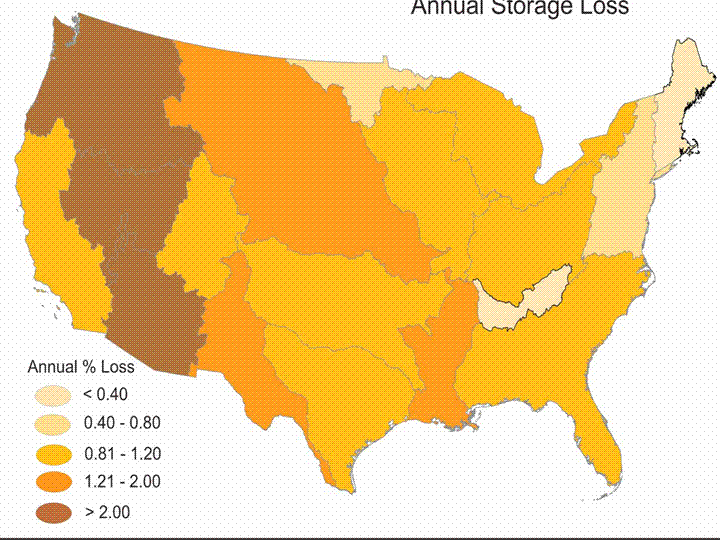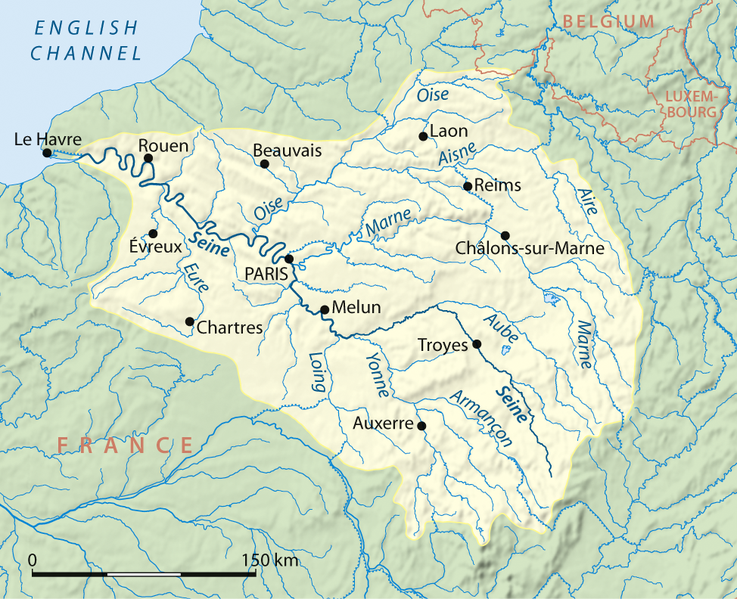The week that was, 12/19-25/2010
Posted on | December 26, 2010 | 1 Comment

Detail of fishing net tapestry "Kalama 1" by Mary Babcock, part of "Hydrophilia" at Hawaii Pacific University. Click on the image to be taken to the university website.
“I think it’s seasonal. The nets seem to wash up during the winter.” — Artist Mary Babcock, maker of tapestries from old fishing nets, Ocean Meditations, Honolulu Star-Advertiser, December 19, 2010
Mexico will leave part of its Colorado River allocation in Lake Mead for the next three years, slowing the decline of the drought-stricken reservoir and possibly delaying the onset of water rationing in Arizona and Nevada. — Colorado River deal aids US and Mexico, Arizona Republic, December 21, 2010
Enough water poured from Los Angeles streets to supply well over 130,000 homes for a year. — In a region that imports water, much goes to waste, Los Angeles Times, December 24, 2010
… with our watersheds nicely saturated by several days of rainfall, today’s predicted storm, if its rainfall is as intense as described on our isohyets, is like the powerhouse batter that can sweep when bases are loaded. Since we’ve built in our floodplains, we probably won’t like that particular home run. — How to figure out a fifty-year storm (and other storms too), LA Creek Freak, December 22, 2010
… much of the Delta is a remote, labyrinthine wateriness that, for most people, exists only in the mind, wrapped in an impenetrable mist. — California’s tangled water politics, High Country News, December 20, 2010
… we can choose to avoid tragedy by placing a higher value on water. — Opinion piece, John Kominoski, University of Georgia; Tushar Sinha, North Carolina State University; William Graf, University of South Carolina; and John Sabo, Arizona State University, Entire southeast needs a new strategy for conserving water, Atlanta Journal-Constitution, December 22, 2010

'Sedimentation and sustainability of western American reservoirs' graphic. Click on the image to be taken to Water Resources Research.
Sustainability varied by region, with the longest life expectancies in New England and the Tennessee Valley and the shortest in the interior west. — ‘Cadillac Desert’ group, extract from the Water Resources Research paper, WaterWired, December 24, 2010
… our hair is substantially less flammable than Atlanta’s. — You don’t have to be dry to be water short, jfleck @ inkstain, December 24, 2010
The government’s efforts to provide drinking water to the people is to benefit only 2 million people in selected districts while the 24 million are left on their own devices. — Drinking water projects ignore 92 pc population, The Himalayan Times, December 24, 2010
 Water trapped in the polar craters, some of which are the coldest spots in the solar system, also speaks to a moon that appears to have its own tenuous water cycle – water changing state and location during the lunar day. — Hey, space hounds! Here’s our top space stories of 2010. What are yours? Christian Science Monitor, December 22, 2010
Water trapped in the polar craters, some of which are the coldest spots in the solar system, also speaks to a moon that appears to have its own tenuous water cycle – water changing state and location during the lunar day. — Hey, space hounds! Here’s our top space stories of 2010. What are yours? Christian Science Monitor, December 22, 2010
“They destroy your life, your water, and for compensation they wave a little bit of money and expect you to take it and abandon your home.” — Dimock, Pennsylvania resident Julie Sautner, Fouled water well spells furor, Pittsburgh Post-Gazette / ProPublica, December 22, 2010
Pennsylvania, which has worked with the industry, saw completion of 632 Marcellus wells in 11 months, which made available 180 billion cubic feet of gas. That doubled the state’s gas production and sparked investment in headquarters, training facilities and service locations as well. But in New York, the ‘green’ lobby, flogging what the Wall Street Journal called ‘dubious environmental fears,’ led state policymakers to stiff-arm the industry. — Editorial, The Marcellus shale benefits Pennsylvania; New York let enviros control the issue and paid a high price, Charleston Daily Mail, December 20, 2010
The gas deposits will remain as a potential energy resource but the environmental problems that would accompany a premature “gold rush” would be devastating and irreversible in New York. — Letter to the editor from Christine C. Quinn, Speaker, New York City Council and James F. Gennaro, Chair, New York Environmental Protection Committee, New York will take the time to get gas drilling right, Wall Street Journal, December 21, 2010
 They [15 oil and gas companies] want to explore more than 50,000 square miles of fields and forests around the Siene and Marne Rivers east of Paris, Public Radio International correspondent Anita Elash on the American invention hydraulic fracturing being considered for use in France, French farmland tapped for oil, PRI’s The World, December 24, 2010
They [15 oil and gas companies] want to explore more than 50,000 square miles of fields and forests around the Siene and Marne Rivers east of Paris, Public Radio International correspondent Anita Elash on the American invention hydraulic fracturing being considered for use in France, French farmland tapped for oil, PRI’s The World, December 24, 2010
… how often do you see a Sacramento developer (Angelo K. Tsakopoulos) team up with a mammoth water purveyor (the Metropolitan Water District of Southern California) to help buy a water-rich ranch in bucolic Yolo County? — Editorial Conway Ranch deal sounds scary but dig deeper, Sacramento Bee, December 21, 2010
“What 11 percent of the body do you want to cut off? How many fingers? How many toes? What part of your head?” — Mickey Newberger, former member of the Atlantic States Marine Fisheries Commission, Worries rise over minimum flow of Chassahowitzka River, St Petersburg Times, December 19, 2010
“The water temperature dropped really fast. It took about 24 hours to go from OK to not OK.” — Florida Fish and Wildlife Conservation Commission biologist Allen Foley, Cold hard on manatees, turtles, Daytona Beach News Journal, December 22, 2010
“We don’t farm with horses anymore. With the surface water system, we had to be at the fields several times each day, which increased fuel and labor cost. I can now irrigate with a touch of a button on my cell phone which can turn my pivot on or off and saves me time and labor.” — Nebraska farmer Roger Wahlgren, Natural Resources District plans to close Six Mile Canal to divert more water to Platte River, Lincoln Journal Star, December 22, 2010
“It’s like lumping arsenic with Vitamin D.” — Rebecca Sutton on measuring total chromium in drinking water, author of Chromium-6 is widespread in US tap water released by the advocates Environmental Working Group, Study finds likely carcinogen in 31 cities’ water; Chemical is cited as a ‘potential health threat’, USA Today, December 21, 2010
The agency regularly re-evaluates drinking water standards and, based on new science on chromium-6, had already begun a rigorous and comprehensive review of its health effects … When this human health assessment is finalized in 2011, EPA will carefully review the conclusions and consider all relevant information, including the Environmental Working Group’s study, to determine if a new standard needs to be set. — EPA press release, December 21, 2010
Keep in mind that there is a lot of naturally-occurring hexavalent chromium. That doesn’t make it good for you, but its presence in water is not part of some nationwide conspiracy by chemical companies to contaminate our drinking water. — On Icebox Europe and CC, Jane Lazgin of Nestlé Waters, Grading, and Hexavalent Chromium, WaterWired, December 21, 2010
This compilation is derived primarily from searches on ProQuest, whose news database is accessible through most public libraries. For California water news, go to Aquafornia, the newsfeed of the Water Education Foundation. For San Diego stories, try Groksurf’s San Diego. Or, for all things fresh water, do check in with WaterWired. For Bay-Delta debate, try On the public record. This site has a compilation of stories on hydraulic fracturing that may be of use to those weighing up arguments about its environmental impact.
This post was updated. The High Country News link was added several hours after posting and the jfleck item was added on Monday, December 27th at the suggestion of Groksurf San Diego (see comments).
Comments
One Response to “The week that was, 12/19-25/2010”
Leave a Reply



December 27th, 2010 @ 9:09 am
On the water situation in the southeast, I like John Fleck’s observations too, capped with the headline: “You don’t have to be dry to be water short.”